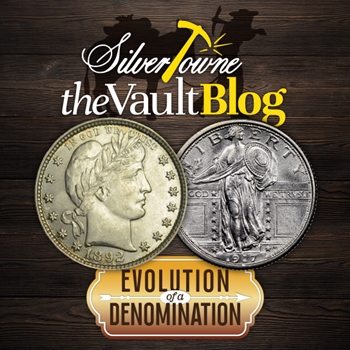
During the issuing years of the Liberty Seated series featuring the quarter dollar, then-Mint Director James P. Kimball made sure to mention in his 1887 annual report that the coinage of the United States was out of date in his opinion. He also stated in that report that it should be updated, enlisting Senator Justin S. Morill to come up with a bill letting the Treasury Department redesign coins without the approval of Congress as long as the current design had been used for 25 years or more. The Seated series had been around since 1837, allowing for the bill to be passed in September of 1890.
Barber or Liberty Head (1892-1916)
Charles E. Barber was appointed the Chief Engraver of the United States Mint in 1869 and still held the position when the bill was passed to change United States coinage in 1890. However, Barber was very against the organized competition that was held by the Treasury Department to find the new designs. He, along with Augustus Saint-Gaudens and engraver Henry Mitchell, were judges of the competition. The result of the competition did not go over very well as Barber and the other judges believed that they could come up with better designs than any of the contestants. At the end of it all, Barber ended up with the support of the new Mint Director Edward O. Leech and was chosen to come up with the new designs.
The Barber quarter was a part of the new series of coins and was adopted in 1892. His initial (B) can be seen on the obverse at the truncation of the neck of Liberty. They were minted from 1892-1916 with the first year issue (1892) having two varieties. The complete series has no rarities as nearly 265 million coins were produced during their mintage run. They were produced in Philadelphia, Denver, New Orleans, and San Francisco.
Barber’s complete coinage series, including the quarter dollar, came at a time when innovation in manufacturing was changing. New techniques were being developed and greater precision took hold, making more detailed design elements easier to produce. Also, Barber’s designs were never really that well received. His designs were said to be “cluttered.” In 1916, another competition was held to replace the design which had reached its 25-year production minimum. A winner was chosen, thus the discontinuation of the Barber coinage and the introduction of the Standing Liberty quarter.
Standing Liberty (1916-1930)
After a competition was held to select the next design for the United States quarter dollar, Hermon MacNeil’s Standing Liberty quarter was born. The design features a full standing, frontal view of Lady Liberty. Produced from 1916-1930, there are just two varieties as a modification was made in 1917 to both the reverse and obverse of the design. However, in 1925, a depression was made in the pedestal that Liberty stands on featuring the date. The newer recessed dates were not easily worn off as they were protected more from 1925-1930.
The coins were struck in Philadelphia, Denver, and San Francisco. Although considered one of the most beautiful designs to date, the Standing Liberty quarter was only struck for fifteen years as the 200th Anniversary of George Washington’s birth took precedence in 1932.
Source: NGC Coin; The Official 2022 Red Book







